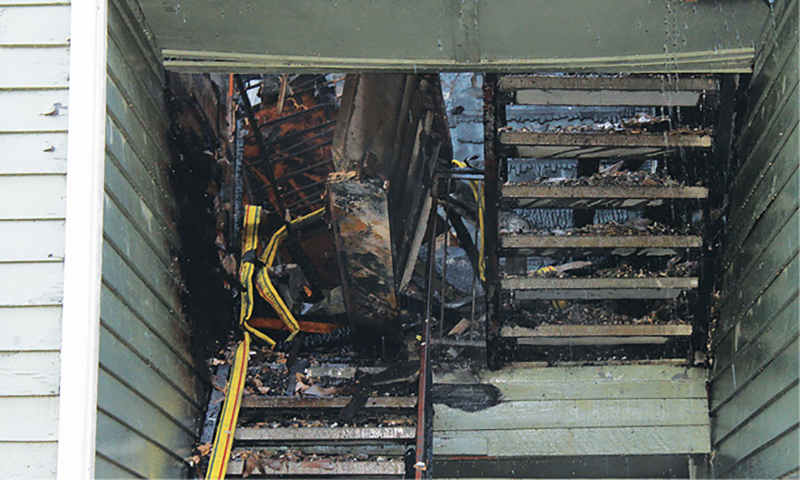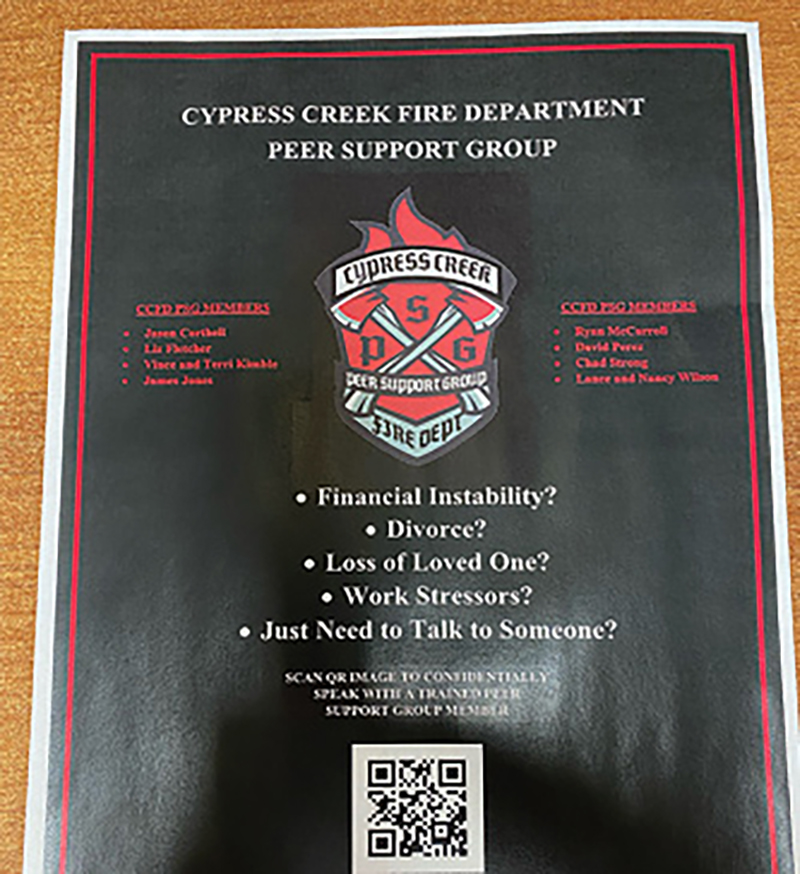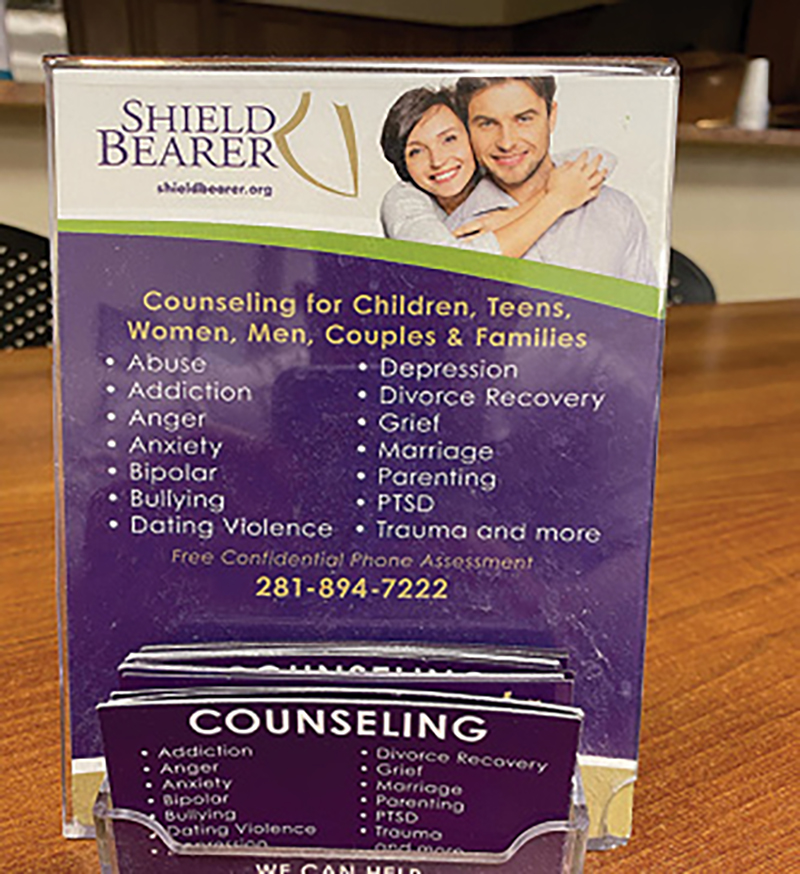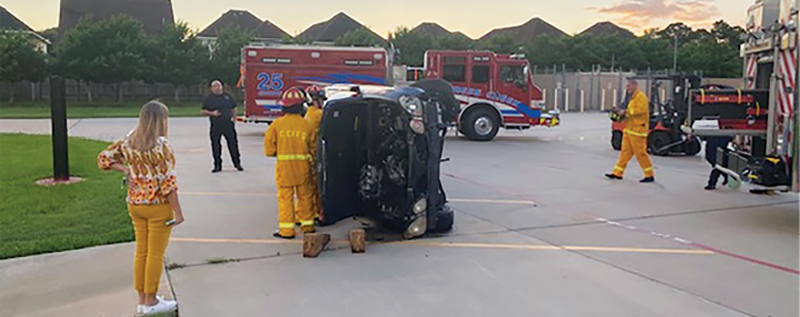By Jason M. Corthell
In 2015, after just having survived a catastrophic collapse while operating in an apartment complex stairwell, I learned that the injuries I had sustained would keep me out of work for at least six months with knee reconstruction (photo 1). Also, I was no longer seeing my three small children every day because of an impending divorce, and I was on the verge of losing my job in the fire service that I once dreamed of. Succumbing to self-pity, I fell deeper into depression and anxiety, associating with people I would normally maintain a distance from and staring in the face of an ugly reality: dependency. I was using alcohol and the poor social relationships that came with it to mask a sad and scary reality.
- Relax, Don’t React for Less Stress, Better Performance, and Well-Being
- The Stress Tetrahedron: A New Way To Visualize First Responder Stress
- Mental Health Care in the Fire Service: It’s Acceptable, But Is It Accessible?
- Don’t Have Any Regrets: The Rosecrance Florian Program
Selfishness has never been in my wheelhouse of emotions or actions, nor has calling attention to myself. Unfortunately, this was all happening to me at once in the worst way. I decided to seek help and fast, prompted by my devotion to my faith, my small children, and the job I had fallen in love with as a child. However, the only two choices available to me were (1) using a formal employee assistance program provided by the municipality in which I worked and (2) finding a private counselor on my own. I look back on these circumstances now and realize how valuable such an internal program could be for first responder organizations, tailored to their personnel’s specific needs.
Despite not having a degree in psychology or being certified in any related area, I have found that mental wellness is significantly important in the fire service. When I was promoted to district chief, I knew what was needed—to find my role or niche in the fire department quickly and, as my great grandpa would advise, leave the fire service better than I entered it. I struggled for a few months, first with being a chief officer and what that meant as a man, a father, a husband, and so forth. Then I struggled a bit with the transition between being one of the crew to taking care of and leading the crew. I wanted to do something I was passionate about that had meaning within the fire service.

(1) Photo by Tom Fleming.
Wellness and Fitness Initiative
My chief assigned me to create a wellness and fitness program that would benefit both the department and the personnel. Luckily enough, we were in the midst of a station remodel that would allow me to take my shot at creating our first gym inside of one of our firehouses. The then-current arrangement was to contract with a local gym in our department’s territory.
Cost efficiency was the intent; I figured that within two years of providing personnel with their own internal gym, the gym would pay for itself compared to our complicated and costly contract with a local commercial gym. Also, the expense would not be another “out of pocket” expense to our citizens, something over which we did battle with at times.
Once our gym was complete and fully operational, I knew, and it has since been proven, that having gyms inside of our firehouses would be a given going forward. Once I completed this program to improve our physical fitness, I looked for other areas to fortify our department’s wellness.
I connected with Dr. Elizabeth Fletcher, who works with the University of Houston Psychology Department’s Trauma and Stress and First Responder programs. We set up a meeting to discuss setting up a proven and lasting mental wellness program. She had been a volunteer with our department and has suffered a suicide in her family. Her passion and drive for this project is incalculable; she has been involved in it as much as I have.
In setting up a program, don’t go it alone, even if you feel you can coordinate it by yourself. It is always beneficial to have a second party to challenge your ideas, provide feedback, and share your failures and successes.
The mental wellness program we developed was foundationally sound and in accord with departmental binding documents such as standard operating procedures, formal agreements, memoranda of understanding, and contracts. An important part of this was our department’s first Federal Victim of Crimes Act (VOCA) grant for more than $244,000, awarded to us in October 2020 to launch our program. Realize that this program was designed to be extremely cost-efficient; the idea of applying for a grant came long after we started. The program was so efficient that, as an organization, we were going to march forward with this program without the grant. Because of its overwhelming success, this operation will continue for years to come.
Three-Tiered Wellness
Our mental wellness project developed into a solid three-tiered approach to most appropriately address the needs and trends we have seen throughout the fire service. Each tier can be developed independent of the others or jointly; they need not be done in any order to provide the best assistance for your members.
Furthermore, you will see confidentiality emphasized throughout our department binding documents. Despite the progress made, a stigma about asking for help still exists. If any tier within the program fails to maintain confidentiality, the entire program is at extreme risk to fail.
Tier I: Chaplaincy
The chaplain is perhaps the most traditional or “seemingly” fitting resource for a firefighter to turn to. Providing confidential faith-based or nonfaith-based counseling to firefighters and their families at times, this person can also recommend resources for further assistance. It is possibly the most valuable asset on scene at incidents involving severe trauma or loss of life.
Our first step in developing our chaplaincy program was to invest in a nonprofit organization that provided chaplaincy service for a small annual fee. The organization provided the traditional service, both faith- and nonfaith-based, according to the first responder’s wishes. In the past, before we developed our program, this was our only outlet. In 2021, we unfortunately lost this service because of a lack of funding related to COVID-19 and its effects on fundraising and donations. Since one-third of our program would lose its support, we needed a Plan B.
I turned to Fletcher and another captain in our department to build our own department chaplaincy program. We gauged their interest level, and they attended the two-day Federation of Fire Chaplains (FFC) course. This gave them their basic certification over two days of intensive, detailed training. Once they obtained a letter from our chief designating them as our departmental chaplains and received letters from their respective religious denominations declaring them religiously fit for service, their FFC certifications became effective. However, note that, unfortunately, there is no governing body to oversee this process, nor is there any mandatory training or certification to be designated as a chaplain for a fire department. Our two chaplains said that the chaplaincy training was very valuable and beneficial for our personnel.
As easy or tempting as it may be to name someone a chaplain based on that person being a good member and regularly attending a house of worship, please do not. Set up some standards and training that an aspiring chaplain should fulfill, and document the process.
Tier II: Peer Support Group
The fire service as a whole has had peer support for ages; spouses sometimes say that fellow firefighters know their spouse better than the spouse does. This may not be ideal in nonfirst responder relationships, but it has been a proven value to firefighters, most the time. Although such firehouse relationships are valuable, they can also be detrimental and, frankly, very harsh at times. Hazing, initiating, brainwashing—you name it—are still present in some sense inside the station. Although the fire service seems to become more tolerant and understanding, we must work hard against the stigma of asking for help and provide our brothers and sisters with a confidential outlet when needed. I am aware voicing our frustrations at home and on the job, airing them out at the firehouse table, is typically sufficient in defusing would-be conflicts among our people. Nevertheless, we need a confidential outlet with trained peers who can relate to these life snags, providing an ear to bend and to recommend further treatment if necessary and agreed to by the party that’s seeking peer support group (PSG) assistance.
We began our PSG member selection with a simple four-question survey:
Would you reach out to a departmental PSG if one were developed?- More than 60% said yes.
- More than 90% said yes.
- More than 50% said yes.
- We created a drop-down list of all department members.
Most importantly, more than 90% of those surveyed recommended in-house peer support service for our firefighters, indicating the need for it. From the list of those who were selected as potential confidants, we selected 15 people and confirmed that they were part of the willing population from their Question 3 responses. We contacted each potential member and selected 15 members.
Your PSG should represent roughly five to 10% of your overall department, depending on your department’s needs. Having too few persons to confide in wouldn’t meet the PSG’s needs as described below; too many people would water down the program and raise concerns about confidentiality. This select group was based on those who most of our department personnel had selected, but they also needed to meet the needs of a highly dynamic and versatile department. I ensured that the PSG included a representative from each of the following groups:
- Each of our three shifts.
- Males and females.
- Married and single.
- All pay designations (our combination department had full-time, part-time, and volunteer members).
- All ranks, from firefighter to chief officer.
- Most importantly, a variety of age and life experience. For example, marital counselors include those who had been married a long or a short time, been divorced, dealt with financial issues, and had children or were childless.
Having PSG members meeting the above criteria will allow us to match the PSG member’s experience to the member’s difficulty. We might set up a firefighter (and spouse) with marriage troubles with someone who has succeeded in pushing through a tough time in their own marriage.
The PSG membership need not be exclusively department members. If a long-time married firefighter has an interested spouse, that person can join the peer support program. Married couples are a great asset to sit down with young firefighter couples and mentor them in their relationship.
Documentation
Like with anything of this magnitude, the documentation behind this program fortifies it with confidentiality agreements, a memorandum of understanding (MOU) outlining the needs and details of the program, and a signature page that states this program and membership in it is voluntary and not compensated. It’s a great benefit to the department as a low- to no-cost option and to the member, who gives his time to a worthy cause for his peers’ benefit.
To join the PSG, potential members must complete a mandatory self-report measure of personality and psychopathology, which they discuss with a counselor. Counselors are available to our PSG members, who may incur secondary trauma from time to time in assisting others with their struggles.
Our PSG members are trained without compensation using a local counseling service that has gone beyond the traditional awareness level of suicide prevention. Our PSG training offered extensive, research-based findings specific to first responders, including the inner workings of how problems develop and persist if not addressed properly. This led into our second day of training, which allowed us to sit down and go through a number of intense scenarios as role players under the watchful eye of skilled clinicians. Other PSG members also watched, critiqued, and complimented the PSG member’s performance. Our ongoing training includes a counseling group to ensure that our PSG members safeguard against their own burnout from dealing with others’ crises. They are encouraged to seek clinician assistance for themselves to handle the stressors of others.
As with the chaplaincy, there are loopholes and ways to get around doing this the “right” way. I beg that you implement proper research and dedication to the program to bring this tier up to par. This was a pipe dream of mine in 2016, but with Dr. Fletcher and support from all the chief and administrative staff, we have made it into the program it is today, five years later. “Measure twice, cut once”; we measured a whole lot to bring a product worth bragging about.
Our station doors have an informational guide listing our PSG members if a firefighter wishes to contact them directly and a QR code. Once scanned, the QR code provides a confidential e-mail that goes to Dr. Fletcher or me to set the memberup with the appropriate PSG member based on the member’s needs (photo 2).

(2) Photos 2-4 by author.

(3)
Tier III: Professional Counseling Services
I began my quest for counseling services for our members with a simple Web search, and it has continued to be one of my single most prized professional relationships. Partnering with a nonprofit counseling group that has professionally qualified and certified clinicians allows for much opportunity and growth inside of a department and out (photo 3).
The partnership started forming in early 2017 as I wondered if the department could offer its firefighters and staff free counseling services. Would I be able to manage it financially? How would the insurance work? Would the counselors be able to understand “us” firefighters and, ultimately, do we need it? Below are some of the hurdles we had to clear to launch this key tier.
Negotiating is not one of my strong points, but relationships are. This enabled me to start my journey to finding a counseling group near the center of our district. This may not be available to you. I met the director and the clinical director to discuss what we needed and they in turn told me what they could provide and at what cost. We didn’t like the first number, so it was back to the drawing board with the department chief to see what we could potentially change without losing the benefit.
The second draft of our wants and needs was agreed on by our department leadership and the counseling agency we had chosen. The MOU that emerged between the department and the counseling center detailed what each party would provide to receive proper services and could be terminated at any time by either party at no cost.
Once the MOU was signed, we looked financially on our end as to what we could use to boost this program with no/low impact. The cost of the sessions originally was around $70 each; the department was willing pay for seven sessions dedicated to the firefighter or the firefighter’s spouse.
If the firefighter’s or his family’s insurance pays for some or all the amount, ultimately, we would be on the hook for the remaining balance, again for up to seven sessions. Now, we are considering offering 10 sessions to any firefighter family members who may be in need at no cost to the firefighter. Currently, in a little over one year since our MOU and our relationship with our counseling center became official, the center has seen 20 first responders and family members. Our MOU describes the services provided, the rate charged, who is qualified to use them, how many initial appointments are authorized, how to proceed if a certified counselor deems more appointments are warranted, confidentiality clauses and exceptions, and a quarterly training agreement for both PSG members and general department personnel. It provides clarity and guidance in the case of a contract breach or disposal of agreement. We required the option of night or weekend sessions for our part-time and volunteer members. This included presentations on such fire service topics as burnout, retirement transitions, suicide prevention/awareness, conflict resolution, finances, and relationships. Additionally, our MOU offered coaching from a certified counselor to help our PSG members.
The work did not stop there; we had to address more details. The VOCA grant enabled us to pay for counselors and their training, purchase materials, and compensate presenters. You don’t need a grant to accomplish most of these things and certainly not to have a successful mental health program. One of the most cumbersome decisions I made as the program director was to bring a counselor to our fire stations to spend time with our personnel. The embedded counselor committed herself to three to four days a week and to visit all four stations on those days to have contact with each station and shift. As you can imagine, some were not so pleased by this. Her task was not to find out their deepest darkest secrets and push them to spill their guts against their will. Instead, she wanted to get a feel for the environment and the firehouse “vibe.” She also rode along on the apparatus responding to scenes.
This counselor turned out to be amazing; most have taken to her and the passion she brings to understand us and our second home. She is now the counseling group’s clinical director and will no longer be making station visits, but she understands what our personnel need. A new counselor will embed and learn about us. In less than one year, our counseling center has provided more than 550 hours to our organization (Figure 1).
Figure 1. 2021 Professional Counseling Use

Figure by author.
Spouse’s Day
Next on our agenda was to provide a spouse’s day for our department. We afforded all 25 spouses in attendance the opportunity for a free morning yoga session, brunch, presentations from our mental wellness partners and our department, and ended with Mike and Anne Gagliano and their presentation on “Challenges of the Firefighter Marriage.” As leaders, it is important that we take care of our firefighters’ relationships at home and their spouses/significant others are a significant part of that. Allowing for these spouses to come and share in fellowship and get to know each another to form a common bond is invaluable today. Consider doing something of this sort for your firefighters’ spouses (photo 4).

(4)
As a fourth-generation firefighter, I am glad I have done my part to develop a fire service that leaves my fellow firefighters fulfilled, wholesome, and better than they were than when they went on shift. Hopefully, my children, potential fifth-generation firefighters, will benefit from it.
Jason M. Corthell is the wellness and fitness director for the Cypress Creek (TX) Fire Department and the division chief in charge of training.

